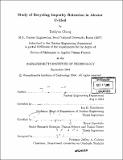| dc.contributor.advisor | Ian H. Hutchinson and Bruce Lipschultz. | en_US |
| dc.contributor.author | Chung, Taekyun | en_US |
| dc.contributor.other | Massachusetts Institute of Technology. Dept. of Nuclear Engineering. | en_US |
| dc.date.accessioned | 2006-07-31T15:19:41Z | |
| dc.date.available | 2006-07-31T15:19:41Z | |
| dc.date.copyright | 2004 | en_US |
| dc.date.issued | 2004 | en_US |
| dc.identifier.uri | http://hdl.handle.net/1721.1/33644 | |
| dc.description | Thesis (Ph. D.)--Massachusetts Institute of Technology, Dept. of Nuclear Engineering, 2004. | en_US |
| dc.description | Includes bibliographical references (leaves 152-154). | en_US |
| dc.description.abstract | This work was aimed at reproducing experimental results in impurity compression of Ar, as well as the screening of recycling and non-recycling impurities from reaching the core plasma. As part of the study the code was upgraded in order to track the impurity flow from source till it reaches the core, include the energy dependence on recycled impurity atoms, and allow for more realistic impurity recycling in the SOL. This added capability allows the determination of which source locations are dominant in determining the core impurity level, where they cross the separatrix into the core and where they leave the core. The modeling reproduces within a factor of 2 the experimentally observed compression of Ar in the divertor of Alcator C-Mod. In addition it was found that under attached conditions recycling at the outer plasma edge (limiters located there) was the dominant source of Ar ions reaching the core (over 60%). For detached conditions divertor recycling replaces the outer edge in supplying the majority of Ar ions reaching the core. | en_US |
| dc.description.abstract | (cont.) There appear to be two general flow patterns of impurities through the core plasma: Outboard launched impurities enter the core at the outside edge and flow out of the core on the inboard edge; Divertor launched impurities enter the core just outboard of the x-point and return to the divertor just inboard of the x-point. The study of non-recycling impurities was also carried out and it was found that the penetration factor (PF) for outboard-launched impurities (Carbon was used as the prototype) were a factor of 3 times more likely to reach the core than inboard-launched impurities (experimental result gave the ratio as 20). Increasing the background SOL plasma flow to the experimental levels doubles the model ratio and other factors capable of reducing the discrepancy are studied. Thus the experimental poloidal variation in PF is qualitatively reproduced. Values of PF for recycling impurities (a global quantity) matched the experimental magnitudes when experimental values for SOL flow were used. | en_US |
| dc.description.statementofresponsibility | by Taekyun Chung. | en_US |
| dc.format.extent | 154 p. | en_US |
| dc.format.extent | 7411940 bytes | |
| dc.format.extent | 7418394 bytes | |
| dc.format.mimetype | application/pdf | |
| dc.format.mimetype | application/pdf | |
| dc.language.iso | eng | en_US |
| dc.publisher | Massachusetts Institute of Technology | en_US |
| dc.rights | M.I.T. theses are protected by copyright. They may be viewed from this source for any purpose, but reproduction or distribution in any format is prohibited without written permission. See provided URL for inquiries about permission. | en_US |
| dc.rights.uri | http://dspace.mit.edu/handle/1721.1/7582 | |
| dc.subject | Nuclear Engineering. | en_US |
| dc.title | Study of recycling impurity retention in Alcator C-mod | en_US |
| dc.type | Thesis | en_US |
| dc.description.degree | Ph.D. | en_US |
| dc.contributor.department | Massachusetts Institute of Technology. Department of Nuclear Engineering | en_US |
| dc.contributor.department | Massachusetts Institute of Technology. Department of Nuclear Science and Engineering | |
| dc.identifier.oclc | 64394814 | en_US |
